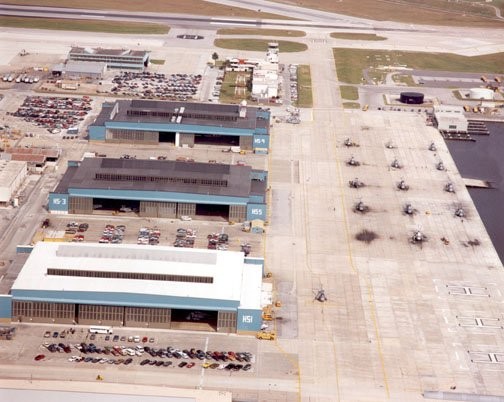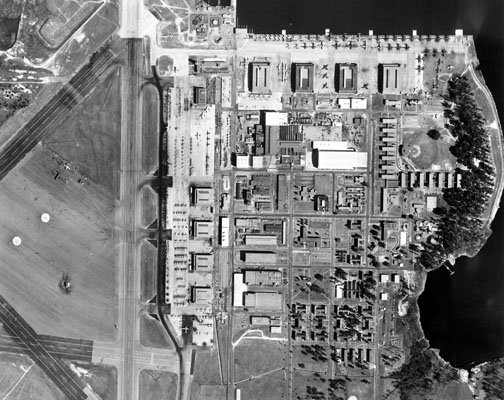Jacksonville Naval Air Station
Introduction
Text-to-speech Audio
Images
JNAS Opening Announcement in 1940

JNAS Hangar Complex (~1970)

Aerial Shot of JNAS (~1960)

St. Edwards Chapel after construction

Backstory and Context
Text-to-speech Audio
The Jacksonville Naval Air Station (JNAS) is the largest Naval base in the Southeast Region of the United States and is the third largest in the country (Welcome). The base can be found just South of Jacksonville along the St. Johns River. Originally purchased in 1907 by the US government for military use, the area was first named “Black Point.” In 1909, the Florida National Guard began training in Black Point. In 1916, an infantry regiment from the Florida National Guard was deployed to the Texas-Mexico border, wherein the green regiment performed exceptionally in encamping without difficulty and was ranked among the best from foreign states (Crowe).
Several years after the breakout of the First World War and increased participation by the United States in the conflict, the base was handed over to the United States Army. With the change of ownership in 1917, so too came a name change. The base was henceforth “Camp Joseph A. Johnston” and would be home to the second largest rifle range in the United States, as well as an operating station for the Quartermaster’s Department, Subsistence Division (History, Annual Report).
Following the end of
the First World War in 1918, the Quartermaster’s Department would be moved from
Camp Joseph A. Johnston; just as well, the rifle range would be disassembled in
1919. Later, in 1926, the U.S. Army relinquished their control of Camp Joseph
A. Johnston back to the Florida National Guard, wherein the base was renamed
again to “Camp Clifford J.R. Foster,” (History).
The base remained
under control of the Florida National Guard until October 15, 1940 when the
location was officially commissioned, earning its long-standing name as the
Jacksonville Naval Air Station. The station would develop gradually through
1941 up until the US’s entry into the Second World War. After American entry,
development of the station increased astronomically. JNAS would complete
construction of three runways over 6,000 feet in length and would maintain a
number of seaplane ramps. Through the Second World War, JNAS would see the
complete training of over 10,000 pilots of various aircraft ranging from
fighters to bombers to supply planes, as well as over 11,000 aircrewmen in a
multitude of positions. Repair infrastructure built following US entry to the
Second World War also allowed JNAS to become a repair hub for Allied aircraft
damaged overseas, securing the location as an essential part of the war effort.
By Victory over Japan Day on September 2nd, 1945, over 700 buildings had been
built, including an 80-acre hospital, the St. Edward’s Catholic Chapel, and a
Prisoner-of-War camp which housed over 1,500 German POWs. Several of these
structures, built only to last for twenty years, are still in use by JNAS to
this day. Following the Second World War, JNAS would become home to the United
States Navy’s first jet carrier air groups and squadrons in 1948. By April of
1949, Jacksonville would be the Plane Capital of the US Eastern hemisphere,
with over 60% of fleet strike power located on the Jacksonville Naval Air
Station (History by Decade).
Peacetime would not settle for long on JNAS, however, as the station was soon called to action once more. With the breakout of the Korean conflict in 1950, JNAS would house even more aircraft, and would once again be brought into play for repairs and training. Even with the Korean conflict ending in 1953, JNAS continued to grow throughout the 1950s, improving its runways with taxiways and air control towers. While the station grew, the surrounding Jacksonville area also grew, bringing business and residents to the then small city. JNAS would employ over 5,000 civilians by the mid-1950s. In 1955, JNAS contributed to the Byrd expedition to the South Pole by outfitting the R4D transport airplane and H04S-3 helicopter to withstand cold weather. As America stepped into the space age, JNAS would also be used for space flight purposes as a tracking and recovery station. While activity would never cease on the base, peacetime calm would settle over the station for the remainder of the 1950s (History by Decade).
The Early 1960s began
in a volatile way for Florida and the US at large. The Cuban Missile crisis saw
the complete blockade of Cuba and being the closest and largest naval station
to Cuba, JNAS was largely responsible for refueling and resupplying the large
American fleet, as well as taking over reconnaissance missions to scout out
potential Cuban missile sites. The peaceful resolution of the Cuban Missile
Crisis did not end military activity for JNAS there, however, as by 1965
America had entered into war with North Vietnam. Unlike the conflicts prior,
however, JNAS played a minimal role; only contributing fixed-wing antisubmarine
squadrons as direct contributions to the war effort. By the 1970s, JNAS would
become more specialized in antisubmarine training, fitting itself for a
changing climate of naval war based around submersibles (History by Decade).
The Jacksonville Naval Air Station remains operational to this day and continues to advance, having received a set of Triton unmanned strike-drone training simulation devices in 2010 and being given a Main Operating Base (MOB) for two Triton Drones in 2018. The MOB may develop further in the future and is already in use world-wide (LaRocque).
Sources
Crowe, Frank H.. Florida National Guard Yearbook 1939. Florida National Guard.
History. CNIC Jacksonville Naval Air Station. . Accessed March 26, 2019. https://www.cnic.navy.mil/regions/cnrse/installations/nas_jacksonville/about/history.html.
History by Decade. CNIC Naval Air Station Jacksonville. . Accessed March 26, 2019. https://www.cnic.navy.mil/regions/cnrse/installations/nas_jacksonville/about/history/history_by_decade1.html.
LaRocque, Kaylee. Triton Mission Control Center officially opens. Jax Air News. May 22, 2018. Accessed April 10, 2019. https://www.jaxairnews.com/news/20180502/triton-mission-control-center-officially-opens.
Welcome to Naval Air Station Jacksonville. CNIC Jacksonville Naval Air Station. . Accessed March 26, 2019. https://www.cnic.navy.mil/regions/cnrse/installations/nas_jacksonville.html.
